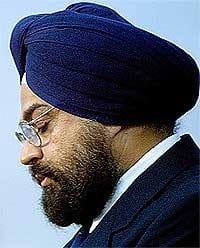


OHIO, USA—Growing up in the Cleveland area after the 9/11 attack, Gurwin Singh Ahuja quickly came to realize that the turbans worn by Sikhs were often misinterpreted to represent terrorism.
Nearly 15 years later, things may have changed a bit, but he believes there’s still work to do.
“The image that we have associated with us is what I think is a media-driven image of what a terrorist would look like — a beard and turban. That image has become an anti-Western image,” Singh Ahuja said.
Instead, he said, Sikh symbols represent very Western ideals.
“A lot of Sikhs wear a beard and a turban as a commitment to equality — for men and women, for anyone to practice their own faith — and also a commitment to ‘wherever you start in life, you can reach the highest level of status,’ ” he said.
“These values are the underpinnings of Western society, so we have this huge confusion, and my community had not done a good job of communicating those values.”
As such, the 25-year-old Singh Ahuja is heartened by a report released this week by the Washington-based nonprofit National Sikh Campaign that indicates that education can have a significant impact on the way members of the faith are perceived.
“Sikhism in the United States: What Americans Know and Need to Know,” released on Monday, includes results of a poll of 1,144 Americans of non-Asian descent conducted online in August and September. It found that 60 percent of those polled knew nothing about Sikh Americans.
When participants were initially asked to rate, on a zero to 100 scale, how warmly they feel about Sikhs, responses came in at an average of about 54. After participants read about Sikh history and beliefs and positive messages about the faith, that average rose to nearly 72.
“When you tell people our values, people’s minds completely change,” said Singh Ahuja, an Ohio State University graduate who co-founded the National Sikh Campaign.
“If we do communicate our values and we do it in an efficient way, we have an ability to build a strong story in this country.”
He said the next step is to plan media campaigns online and on television and at the grass-roots level. The campaign is working to raise funds and create awareness in New York and Chicago and on the West Coast.
Not all Sikhs find difficulty in the United States. Ravinder Singh Taneja, who grew up in Singapore and India, said he has “had a ball” during the 40 years he has been in the United States, although he did feel a little uncertain after the 2001 terror attack. He has lived in central Ohio since 1997.
The Sikh community here has held dialogues with police officers and others to create awareness, but efforts could be stepped up, he said. Sikh values, he said, are “as American as apple pie,” and he makes it a point to explain them to his friends and others.
“I find that the people are very receptive when you talk to them, and it surprises them that we could look so different yet be so alike in our value system,” said Singh Taneja, 62.
According to the report, the most effective messages are those that refer to Sikh values that echo American values, such as the right for all to “life, liberty and the pursuit of happiness,” and references to Sikhs as people who immigrated to the United States to build a better life for their families through hard work.
The monotheistic faith traces its roots to southern Asia about 500 years ago. Followers believe in 10 teachers, called gurus, who have led to the most recent teacher, which is the Sikh scripture called Guru Granth Sahib.
Singh Ahuja said some Sikh practices came in response to India’s caste system. Turbans and beards were associated with higher classes, and Sikhs felt everyone should wear them to represent equality. The same can be said, he added, for the reason Sikhs all have “Singh” (it means “lion”) in their surname.
Singh Ahuja said Sikhs around the world have been bullied, beaten up or even killed because they were incorrectly identified as terrorists in the 9/11 aftermath.
He stressed that the report does not mean Sikhs are trying to distance themselves from Muslims.
“I’m not trying to run away from my Muslim brothers and sisters,” he said. “I feel like they get a raw deal as much as we do, and they’re fighting that same kind of caricature that we’re trying to get away from.”




